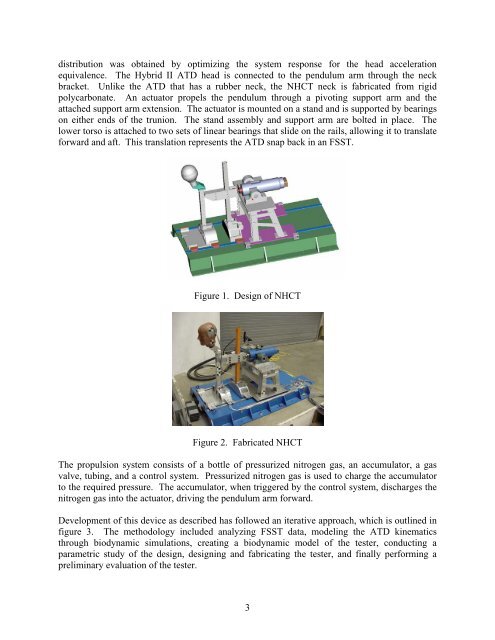Development of a Component Head Injury Criteria (HIC ... - FAA
Development of a Component Head Injury Criteria (HIC ... - FAA
Development of a Component Head Injury Criteria (HIC ... - FAA
You also want an ePaper? Increase the reach of your titles
YUMPU automatically turns print PDFs into web optimized ePapers that Google loves.
distribution was obtained by optimizing the system response for the head acceleration<br />
equivalence. The Hybrid II ATD head is connected to the pendulum arm through the neck<br />
bracket. Unlike the ATD that has a rubber neck, the NHCT neck is fabricated from rigid<br />
polycarbonate. An actuator propels the pendulum through a pivoting support arm and the<br />
attached support arm extension. The actuator is mounted on a stand and is supported by bearings<br />
on either ends <strong>of</strong> the trunion. The stand assembly and support arm are bolted in place. The<br />
lower torso is attached to two sets <strong>of</strong> linear bearings that slide on the rails, allowing it to translate<br />
forward and aft. This translation represents the ATD snap back in an FSST.<br />
Figure 1. Design <strong>of</strong> NHCT<br />
Figure 2. Fabricated NHCT<br />
The propulsion system consists <strong>of</strong> a bottle <strong>of</strong> pressurized nitrogen gas, an accumulator, a gas<br />
valve, tubing, and a control system. Pressurized nitrogen gas is used to charge the accumulator<br />
to the required pressure. The accumulator, when triggered by the control system, discharges the<br />
nitrogen gas into the actuator, driving the pendulum arm forward.<br />
<strong>Development</strong> <strong>of</strong> this device as described has followed an iterative approach, which is outlined in<br />
figure 3. The methodology included analyzing FSST data, modeling the ATD kinematics<br />
through biodynamic simulations, creating a biodynamic model <strong>of</strong> the tester, conducting a<br />
parametric study <strong>of</strong> the design, designing and fabricating the tester, and finally performing a<br />
preliminary evaluation <strong>of</strong> the tester.<br />
3

















